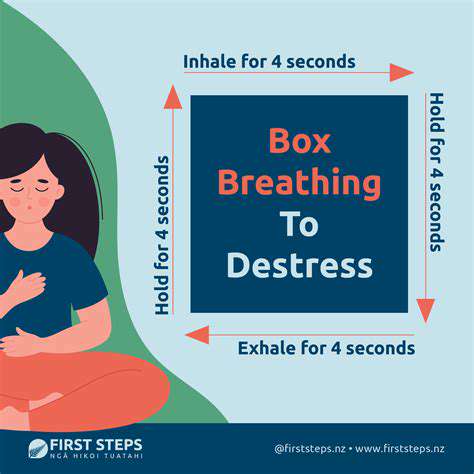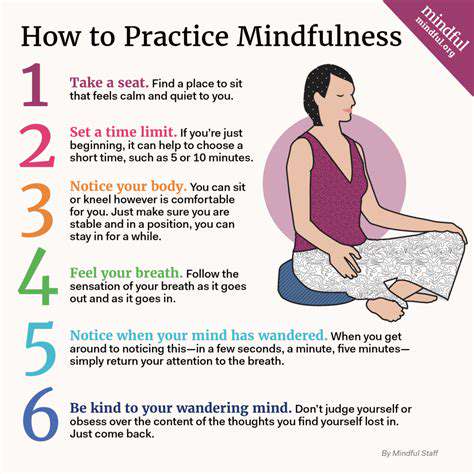Breathing Exercises for a Panic Attack: Effective Techniques

Understanding the Fundamentals of Box Breathing
Box breathing, often called square breathing, is a deceptively simple technique with profound effects on both body and mind. Picture this: you inhale, hold, exhale, and pause—each for equal counts—creating a structured rhythm that mimics the sides of a box. What makes this method so remarkable is its universal accessibility; whether you're at your desk or in a crowded subway, it's always within reach as a stress-relief tool.
At its core, box breathing works by establishing symmetrical breath phases. This intentional pacing creates a physiological reset button, slowing your heart rate and signaling safety to your nervous system. Many find that after just a few cycles, their racing thoughts begin to settle like snowflakes landing gently on a still pond. The real magic happens when you realize that controlling your breath means controlling your emotional landscape.
Applying Box Breathing Techniques
Here's how to make it work for you: Settle into any comfortable position—perhaps in your favorite chair or lying on a yoga mat. Breathe in through your nose for four slow counts, imagining filling your lungs from bottom to top like pouring water into a glass. Hold that breath for four counts, noticing how your ribcage expands. Then exhale completely for four counts, as if fogging up a mirror. Finally, pause empty for four counts before beginning anew. This isn't just breathing; it's composing a symphony with your respiratory system.
Like learning any new skill, mastery comes with repetition. Start with three complete cycles per session, gradually building to five or more. While the classic 4-4-4-4 rhythm works well, some adapt it to 5-5-5-5 or even 3-3-3-3 when starting out. The critical element isn't the number but the equality of phases. This ancient practice has survived centuries because it delivers tangible results with minimal equipment.
Benefits and Applications of Box Breathing
The applications of box breathing read like a wellness wishlist: from diffusing panic attacks before they escalate to sharpening focus during important presentations. Navy SEALs reportedly use it to maintain composure in combat situations, while CEOs employ it before high-stakes negotiations. What begins as a breathing exercise often blossoms into a personal empowerment tool, giving practitioners command over their physiological responses.
Athletes incorporate box breathing to optimize oxygen efficiency during competitions, while chronic pain patients use it to disrupt the pain-stress cycle. New research suggests it may even help regulate blood pressure. The true beauty lies in its versatility—whether you're a student facing exams or a parent navigating toddler tantrums, this technique adapts to your needs.
Understanding your audience remains the cornerstone of successful business strategy. Just as box breathing requires tuning into your body's rhythms, effective market research demands listening to your customers' unspoken needs and desires.
Mindful Breathing for Long-Term Anxiety Management

Mindfulness and Breathing Techniques
Mindful breathing differs from other techniques by emphasizing awareness over control. Instead of manipulating your breath, you become a curious observer—noticing how air feels cooler entering your nostrils and warmer leaving them. This non-judgmental observation creates space between stimulus and response, breaking anxiety's automatic grip. Picture your breath as a swinging pendulum—your attention gently follows its natural arc without trying to alter its rhythm.
The cumulative effect of daily mindful breathing resembles compound interest for your nervous system—small, consistent deposits yield significant long-term returns. Many practitioners report developing a sort of mental immunity, where stressors that once triggered panic now register as passing clouds rather than thunderstorms.
Benefits of Consistent Practice
Neuroscience reveals fascinating changes in regular practitioners' brains—the amygdala (fear center) shrinks while the prefrontal cortex (rational thinking area) thickens. This biological remodeling explains why veterans of mindful breathing often describe feeling less reactive to life's ups and downs. It's not that problems disappear, but your relationship to them transforms—like switching from riding rollercoasters to observing them from a park bench.
Sleep improvements frequently surprise newcomers. The simple act of focusing on breath rhythm signals safety to the body, easing the transition into restful states. Some combine it with progressive muscle relaxation for enhanced effects—imagine your breath as a wave washing tension from your toes to your scalp.
Practical Application in Daily Life
Modern life offers countless opportunities for micro-practices: waiting for coffee to brew, sitting at traffic lights, or during work breaks. I once witnessed a surgeon practice mindful breathing between incisions—proof that even high-stakes environments accommodate this practice. These stolen moments accumulate into what one might call breath equity—a reservoir of calm you can draw upon during challenging times.
Creative adaptations abound: sync your breathing to footsteps during walks, or match it to typing rhythm while working. One teacher I met practices with students before exams—they call it taking their mental temperature.
Techniques for Enhancing Your Practice
Seasoned practitioners often develop personalized variations. Some visualize breathing in calming blue light and exhaling gray tension. Others focus on the subtle pause between breaths—that fleeting moment of perfect stillness. The most effective technique is whichever keeps you returning to practice; there's no right way to breathe mindfully.
Combining techniques can yield interesting results. Try box breathing for structure, then shift to mindful observation. Or alternate between belly breathing and chest breathing, noticing how each affects your mental state differently.
Overcoming Challenges and Maintaining Motivation
Initial hurdles often include unrealistic expectations. This isn't about emptying your mind—that's as natural as stopping river flow. Instead, think of it as noticing when you've drifted downstream and gently paddling back. Each return to focus strengthens your attention muscles, much like how lifting weights builds physical strength through repetition.
Tracking progress helps maintain motivation. Note subtle changes: perhaps you caught an anxious thought earlier, or recovered from irritation faster. These small victories reveal the practice's cumulative power. Some find community support invaluable—whether through apps, classes, or simply practicing with a friend.